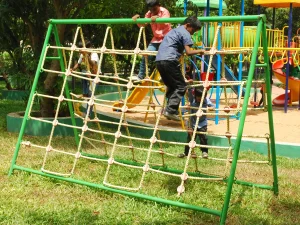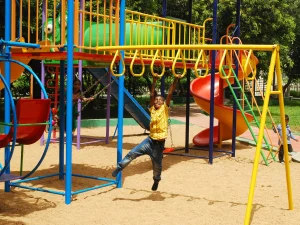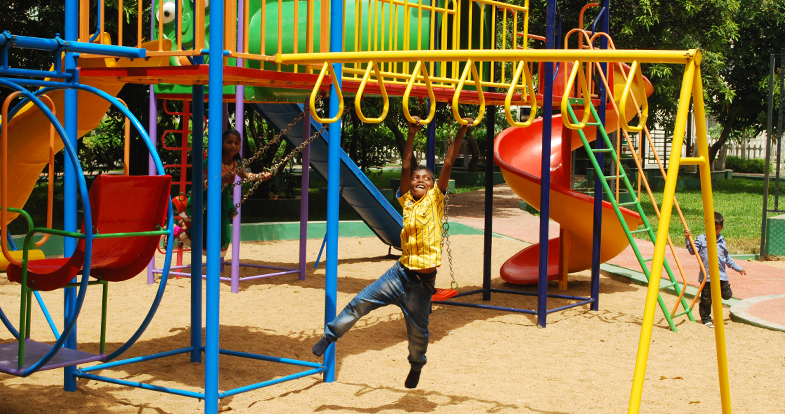Getting some fresh air in today’s day and age has become an increasingly difficult task. Nowadays, kids spend most of their time in front of a screen. While digital media may contain an abundance of useful information for your young children, outdoor play has other benefits to offer for the development of their brains.
Part of a toddler’s growth is their experience in a social setting such as the kid’s playground. Park visits not only help develop a child’s physical strength but also help in the enhancement of their emotional, mental and social mindset.
This ‘social scene’ that is the playground presents many new and unexplored avenues for your child. Children learn to create bonds between themselves that soon leads to the formation of new friendships. They learn values such as Empathy, Patience, Conflict Resolution, Compromise and Sharing. These values are a key part of understanding how to maintain social relationships and develop people skills.
Frequent visits to the play park can help them acquire more than just social skills. It helps to physically stimulate the child and develop motor and cognitive skills such as Agility, Balance, Coordination, Muscle strength and Speed.
And not to forget the added bonus of some much-needed vitamin D that can only be enjoyed at the outdoor playground!

Personality Development
EMPATHY
In a playground setting children are exposed to various new things. One of the new challenges they will face is meeting new people.
Empathy is the ability to comprehend and share the feelings of another. Active listening is an important part of demonstrating an empathetic mindset. Lending an ear when their peers are having a bad day or trying to understand their experiences without any judgment can build an environment for every child to grow in harmony.
Teaching them to accept new people at the outdoor playground or the inclusive park (hyperlink) is a great way to instill empathy in them. Meeting new children will help them realize that every child is unique and beautiful in their own way.
Empathy can help create a cohesive play setting for every child at the park. Playgrounds promote values such as love, acceptance, and patience which are important lessons for children.
You can introduce the concept of empathy by helping them identify different emotions by giving names. Then ask them to focus on that emotion and recognize the different words associated with it.
PATIENCE
The park can also teach children patience, which is essential for their growth. It helps them control their aggression and impulsivity or prevents them from behaving in a disorderly manner.
Teach your child that it is okay to wait for their turn and not rush others. Patience will help your child grow into a young adult who regulates emotions and controls anger, allowing your child to demonstrate self-control and build resilience. It shows them the importance of thinking before you act and how to stay focused on a goal even if the results aren’t immediate.
Simple exercises such as breathing techniques or counting up to 10 are great ways to introduce the concept of patience to your children. Make sure they speak calmly and reward them for their behavior with positive reinforcement.
CONFLICT RESOLUTION
Children need the right tools to articulate how they feel and to voice their opinions. When they do not feel heard or lack the proper communication skills they resort to physical fights and verbal battles.
In situations where a child is faced with disagreements and disputes, it is critical for them to respect themselves and those around them. They should practice active listening and know when to back out of a fight. Understanding to manage and express their thoughts and feelings are also things that they will learn when they are presented with such situations. They start to see that other children have different perspectives from their own.
Children may have tiffs between themselves when trying to take turns at riding the slide or the swing. Here, would be a good time to teach our children the positive ways in dealing with such situations by negotiating and reaching a mutual agreement. Taking turns to ride the swing with the other children or playing with other equipment while waiting for their turn are good ways to start. Reinforce the concept of patience and empathy when teaching them how to settle disputes.
COMPROMISE
Learning to compromise is an important skill for children to develop. Managing differences in a calm and collected manner is key to their long-term development. Sharing their sandbox items, taking turns and scheduling their playtime on each playground equipment are ways children can learn and practice compromise on the playground.
Finding ways to listen, understand, negotiate and adjust with other children is all part of the learning experience. Through this kind of cooperative play, they will learn to solve simple disputes by reaching a fair and mutually satisfying solution.
It teaches them to be tolerant, respectful and trustworthy, which are critical to their personality development. The ability to compromise will help them grow in their workplace and in their personal lives.
Compromise can be introduced to them by telling them that both parties need a win-win and showing them that resolving conflicts is a way to compromise.
SHARING
“Happiness quite unshared can scarcely be called happiness; it has no taste.”
― Charlotte Bronte
Sharing is an essential part of cooperative and collaborative play. Sharing is a result of empathy: teaching them how to consider others’ needs, express themselves with clarity and find creative ways to share with others.
This helps them recognize that other children have the same desires as them. Taking turns to use the playground equipment is a way of teaching children equality and that everyone gets a chance.
Children without siblings may not have the environment to practice sharing on a regular basis. Playgrounds fill this gap by providing them a space to practice sharing with their peers.
Encourage them to give chances to their peers while using the playground equipment made for single players such as the single-seat riders. Let them know that when they share everyone can have a good time: their actions can make people happy. Praise your child with positive affirmations when you see them sharing. It encourages them to continue sharing.
Apart from the personality developmental impacts the children’s playground has on a child, it also has very evident motor skill development opportunities. They are agility, balance, coordination, muscle strength and speed.

Physical Development
AGILITY
The swift changes in direction, speed and body position required to move through spaces is known as agility: an essential skill in a child’s physical development. Agility can help them when sprinting and encountering a sudden obstacle in their path by moving out of the way or decelerating their speed. It engages their motor control, helps them adapt and react quickly to external stimuli, and requires concentration and focus to finish their tasks.
Children’s Park equipment requires children to exercise agility. Equipment such as the Stepping stones develop their bodily movements in ways that they may move quickly and balance their bodies when hopping from one stone to the next, the rope climbers test their dexterity and train their hand-body coordination and the monkey bars enhance children’s agility when they move from bar to bar while focusing on the correct body placement and alignment for the task.
BALANCE
Balance is essential to maintaining proper posture and finding the their centre of balance in their body so they do not fall. Children when they first learn to walk require balance to ensure their bodies are centred and stable as they take their first steps.
They can practice their balance through simple tasks in the children’s park. Balance is required when children climb up the stairs to reach the wide slide and centres their weight when sliding down. Balance can also be seen when a child sits on a swing and adjusts themselves to be centred as they move back and forth in a swinging motion. See-saws help children process their environment, gain awareness of their physical self and understand body coordination to stabilize themselves. Balance beams are designed to improve flexibility and stability. Balance and Coordination go hand in hand
COORDINATION
Coordination is required to complete various simple tasks smoothly and efficiently: walking, running, climbing and jumping. As they work on moving their bodies naturally, they also improve their awareness of their surroundings.
Coordination is key for when a child learns to take their first step. First learning how to balance themselves on their two feet and then slowly managing those first few steps.
Outdoor Swings are a great way for your child to develop their bodily coordination. Stretching their leg outward with force when the swing moves forward and then folding your knees back when moving backwards, require you child to understand how to coordinate their body with the movement of the swing to keep it going. They also learn rhythm and balance.
Similarly, you can see it when they climb the rainbow ladder. They use hand-eye coordination to move up ensuring that their steps are made carefully as the grasp the hand bars to move themselves.
MUSCLE STRENGTH
Children can develop muscle strength by simply running, jumping, climbing, hanging, grasping and swinging. Both fine and gross motor skills are exercised and engaged at the outdoor playground.
Fine motor skills can be seen when a child holds onto a ball or grasps the rope when they climb: the ability to smoothly perform these movements with the help of their fingers, wrists and hands.
Gross motor skills can be seen when a child jumps from one stepping stones to the other or when they simply walk across the playground: Moving their entire body with the help of their bigger muscle groups to accomplish larger movements.
Simple playground equipment like straight ladders , alphabet climbers , roman rings and jungle gyms aid in building your child’s muscle strength. The Elliptical trainer mimics a running activity and helps in building the muscles of their body. The Loop Rung helps children understand their surroundings while also working on their grip strength: fine motor muscles, upper body and core muscle groups. Besides improving flexibility and their stability, it also strengthens the chest, shoulders, and arms and improves their awareness of one’s own movement, strength, and bodily position.
SPEED
Speed is how fast your body can move in a single direction, unlike agility which has to do with directional changes with proper posture and speed modulations. Speed requires coordination, balance, and focus. Speed also develops a child’s hand-eye coordination and reaction time.
Speed can be fast or slow and introduced to your child in different ways. It can be seen in how rapidly someone climbs up the straight ladder or how fast a standing rotor goes or how quickly a child can throw a ball. Children can also experience speed in the special children’s merry-go-round by how fast it rotates.
Speed and agility are required for games such as basketball, football, hockey and more.
You can practice some fun activities at the children park to help them develop their speed. Like timing how fast they descend down the spiral slide or how fast they can scale up the dome climbers . You can encourage children to play running races among themselves to develop the necessary muscles for the task. This will enable them to practice speed.
It’s safe to say, the outdoor playground is a fun and exhilarating space for children to exert their energy and soak up the sun. Parks are where children can break boundaries and barriers and create unmatchable synergy with their peers. A space such as the Kid’s Playground builds our younger generations’ minds.

